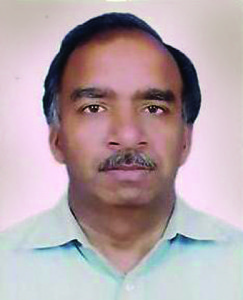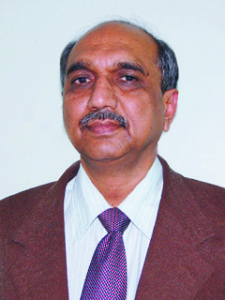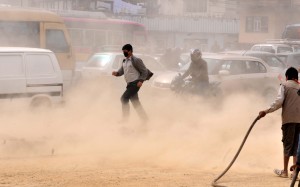Health in Peril
Air pollution is a contributing factor for the burden of respiratory and cardiovascular illnesses, increased health-care costs, lost worker productivity, as well as reduced life expectancy among local populations.
By Amresh Kumar Tiwary
 Air quality deteriorated alarmingly a day after Diwali as pollution levels spiked more than five times higher than normal badly impacting millions of lives.The Respirable Suspended Particulate Matter (RSPM), which directly affects breathing, has gone up by five times from the national ambiance air quality standard, stated scientists from System of Air quality and Weather Fore casting and Research (SAFAR).
Air quality deteriorated alarmingly a day after Diwali as pollution levels spiked more than five times higher than normal badly impacting millions of lives.The Respirable Suspended Particulate Matter (RSPM), which directly affects breathing, has gone up by five times from the national ambiance air quality standard, stated scientists from System of Air quality and Weather Fore casting and Research (SAFAR).
The 24-hours average of PM10 was recorded at 427mg per cubic metre and PM2.5 was at 278mpcm, almost five times higher than the prescribed standard of 100mpcm and 60mpcm respectively
The health sector can play a central role in the formulation of a multi-sectoral approach to the prevention of exposure to air pollution. It can engage and support other relevant sectors (transport, housing, energy production and industry) in the development and implementation of long-term policies to reduce the risks of air pollution on health.
According to Padamshri Dr K Agarwal, National President(Elect) of Indian Medical Association (IMA), New Delhi, these pollutants can harm the heart and brain as well. People with existing heart or lung diseases such as asthma, chronic obstructive pulmonary disease, congestive heart disease, or ischemic heart disease are at increased risk of admission to hospitals based on the severity of already existing problem.
 Dr Anup Mohta, Senior Child Specialist, Chacha Nehru, Bal Chikitsalay, East Delhi, said, “The United Nations Children’s Fund in a report entitled Clean the Air for Children, released recently, said that nearly 20% of the world’s children who live in India risked developing life-long health complications due to air pollution and in some cases even death.”
Dr Anup Mohta, Senior Child Specialist, Chacha Nehru, Bal Chikitsalay, East Delhi, said, “The United Nations Children’s Fund in a report entitled Clean the Air for Children, released recently, said that nearly 20% of the world’s children who live in India risked developing life-long health complications due to air pollution and in some cases even death.”
Dr Mohta added, “Children are uniquely vulnerable to air pollution – due both to their physiology as well as to the type and degree of their exposure.That is because they breathe twice as fast as adults, taking in more air and pollutants which can adversely affect their growth and immune system.”
A report says that outdoor air pollution in India exceeds nearly six times that of limits considered safe internationally, while more than half of the country’s population still burns solid fuels for cooking and heating, often the causes of ill health and early death in children.
Alarmed at the current air pollution levels in the city, the Delhi high court recently termed it like living “in a gas chamber“ and demanded an immediate action plan from the Centre and the state government to combat deteriorating air quality.
Zeroing in on emissions by vehicles and construction related particulates as key pollutants in the capital, the court recently ordered a clampdown on both, asking the government agencies to take steps.“The level of PM2.5 has crossed level of 60, still the government hasn’t done anything” the court said, dismissing the plans filed by the environment ministry and the Delhi government as not comprehensive.
As per a report, many families with elderly members ailing from respiratory illnesses have installed oxygen cylinders at home for emergency purposes because they can’t keep running to the hospital for every frequent breathing crisis that arises. The medical practitioners feel that problem needs the attention of not just a single man, but of an entire system, whose combined effort must be to make whole capital city’s air breathable again.
After a neck-and neck race with Beijing over the past few winters, Delhi may soon find itself without a rival for the `most-polluted-city’ crown. The Chinese city is doing its best to fall behind although, as happened last week, it sometimes nudges ahead with a wind-aided spurt.
 Dr Vinay Aggarwal, Ex-President, Indian Medical Association, New Delhi and Founder Chairman, Max Superspeciality, Vaishali (Ghaziabad), said, “No doubt, the air quality of capital of India is being deteriorated day by day due to increasing level of pollution. Despite precautions, many are experiencing the adverse effects of poor air. Almost all of them claimed to be suffering from respiratory problems or chest congestion.”
Dr Vinay Aggarwal, Ex-President, Indian Medical Association, New Delhi and Founder Chairman, Max Superspeciality, Vaishali (Ghaziabad), said, “No doubt, the air quality of capital of India is being deteriorated day by day due to increasing level of pollution. Despite precautions, many are experiencing the adverse effects of poor air. Almost all of them claimed to be suffering from respiratory problems or chest congestion.”
Dr Vinay Aggarwal added, “The health interventions must be guided by both emission and exposure estimates. A policy that addresses multiple sources of pollution will be critical for prevention and dealing with existing health impacts of air pollution. This is why we have recommended representation of many ministries and coordination between them. The health effects of air pollution highlighted by the committee range from childhood pneumonia and asthma to cardiovascular diseases (heart attacks and strokes), chronic lung disease, cancers and low immunity in adults.”
It is not simply those who spend a lot of time outdoors who are affected. Even month-old babies are found to be suffering from blockage of the nose due to pollutants. They are unable to breathe normally. All doctors can do is to open up the upper airway by administering saline drops.
Exposure to high levels of air pollution can cause a variety of adverse health outcomes. It increases the risk of respiratory infections, heart disease, stroke and lung cancer. Both short and long term exposure to air pollutants have been associated with health impacts. More severe impacts affect people who are already ill. Children, the elderly and poor people are more susceptible.
The most health-harmful pollutants – closely associated with excessive premature mortality – are fine PM2.5 particles that penetrate deep into lung passageways. Although air quality in developed countries has been generally improved over the last decades, the adverse health effects of particulate air pollution, even at relatively low levels, remain a global public health concern.
What is particulate matter?
Particulate matter, or PM, is the term for particles found in the air, including dust, dirt, soot, smoke, and liquid droplets.Large concentrations of particulate matter are typically emitted by sources such as diesel vehicles and coal-fired power plants. Particles less than 10 micrometers in diameter (PM10) pose a health concern because they can be inhaled into and accumulate in the respiratory system. Particles less than 2.5 micrometers in diameter (PM2.5) are referred to as “fine” particles and pose the greatest health risks. Because of their small size (approximately 1/30th the average width of a human hair), fine particles can lodge deeply into the lungs.
Worldwide 3, 7 million premature deaths are attributable to ambient air pollution in 2012. 2 About 88% of these deaths occurs in low and middle income countries.
Regional breakdown (low and middle income countries)
The Western Pacific: 1 670 000 deaths
South East Asians regions: 936 000 deaths.
Eastern Mediterranean region: 236 000 deaths
Europe: 203000 deaths
Africa: 176000 deaths
Americas: 58000 deaths
Regional breakdown (high income countries)
Europe: 279000 deaths
Americas: 94000 deaths
Western Pacific: 68000 deaths
Eastern Mediterranean countries: 14 000 deaths
The WHO maintains a worldwide, public database on urban outdoor air pollution in its Global Health Observatory. The database contains measured outdoor air pollution levels of PM2.5 and PM10 from 1100 cities in 92 countries for the years 2003-2010. These are used for estimating mean annual exposures of the urban population to fine particulate matter. In 2013, WHO began collaborating with major institutions and agencies worldwide in the development of a global air pollution platform that includes data on air pollution concentrations based on satellite monitoring, chemical transport models and ground measurements, inventories of pollution emissions from key sources, and models of air pollution drift – permitting estimates of air pollution exposures even in areas where there are no ground level monitoring stations.
 Dr S P Yadav, Member, Medical Council of India, New Delhi, said, “Governments can identify their main sources of ambient air pollution, and implement policies known to improve air quality, such as promotion of public transport, walking, and cycling (rather than transport relying on private motor vehicles); promotion of power plants that use clean and renewable fuels (e.g. not coal), and improvements in the energy efficiency of homes, commercial buildings and manufacturing.”
Dr S P Yadav, Member, Medical Council of India, New Delhi, said, “Governments can identify their main sources of ambient air pollution, and implement policies known to improve air quality, such as promotion of public transport, walking, and cycling (rather than transport relying on private motor vehicles); promotion of power plants that use clean and renewable fuels (e.g. not coal), and improvements in the energy efficiency of homes, commercial buildings and manufacturing.”
Essential accompanying steps include increasing awareness about the high disease burden from ambient air pollution and its main sources, as well as highlighting the importance of taking action now to implement country-specific interventions. In addition, the use of effective monitoring to evaluate and communicate the impact of interventions is also an important tool in raising awareness. It can help drive policy action that brings benefits for health, climate and the environment.
WHO estimates that 12.7% of deaths could be averted by improving air quality worldwide. Lower levels of air pollution will reduce the burden of respiratory and cardiovascular disease-related illnesses, health-care costs, and lost worker productivity due to illness, as well as increasing life expectancy among local populations. In addition, actions that reduce ambient air pollution will also cut emissions of short-lived climate pollutants, particularly black carbon which is a major component of soot emissions from diesel vehicles, and other sources, as well as greenhouse gases (CO2) contributing to longer-term climate change impacts. Climate change produces a number of adverse effects on health. This includes those from drought and extreme weather events (e.g. windstorms, floods), such as water-borne and food-borne diseases. It also increases the prevalence of vector-borne diseases like dengue or malaria.
Air pollution is an important determinant of public health. Today, this is especially the case in developing countries where exposure to air pollution is now higher than in developed countries, where mitigation measures led to reductions in exposure. There is significant inequality in the exposure to air pollution and related health risks: air pollution combines with other aspects of the social and physical environment to create a disproportional disease burden in less affluent parts of society.
Mortality from ischaemic heart disease and stroke are also affected by risk factors such as high blood pressure, unhealthy diet, lack of physical activity, smoking, and household air pollution. Some other risks for childhood pneumonia include suboptimal breastfeeding, underweight, second-hand smoke, and household air pollution. For lung cancer, and chronic obstructive pulmonary disease, active smoking and second-hand tobacco smoke are also main risk factors. These risk factors may contribute to deaths that are caused by ambient air pollution.
Reducing the public health impacts of ambient air pollution requires addressing the main sources of the air pollution, including inefficient fossil fuel combustion from motor vehicle transport, power generation and improving energy efficiency in homes, buildings and manufacturing. Reducing the health effects from ambient air pollution requires action by public authorities at the national, regional and even international levels. Individuals can contribute to improving air quality by choosing cleaner options for transport or energy production.


